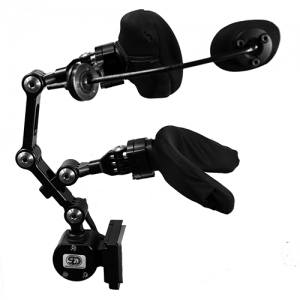Dynamic Seating and Transportation: Dynamic Head Support Hardware considerations
Michelle L. Lange, OTR/L, ATP/SMS
updated 11/11/2024
 This is the third blog in a series on transporting people in their wheelchair while using Dynamic Seating components. This final installment addresses transportation while using Dynamic Head Support hardware. The first two blogs also included current testing standards for transporting wheelchairs in a motor vehicle.
This is the third blog in a series on transporting people in their wheelchair while using Dynamic Seating components. This final installment addresses transportation while using Dynamic Head Support hardware. The first two blogs also included current testing standards for transporting wheelchairs in a motor vehicle.
Current recommendations are to place the head support pad as close as possible to the back of the head and that the top of the pad should be at least an inch above the top of the ears to reduce potential neck injuries in a crash (Fuhrman, et al., 2009). Dynamic headrests and/or head support hardware have not been specifically crash tested on wheelchairs. In discussions with one of the authors of the wheelchair transportation guidelines however, she believes that Dynamic Seating at the head could actually absorb some of the forces during a collision and therefore is a safety advantage.
More research has been completed in the automotive world. Volvo, for example, has a Whiplash Protection System (WHIPS) that dampens force during a collision by providing movement at the driver’s seat back and headrest. This has been shown to decrease neck related injuries. Similarly, a Dynamic Back and Dynamic Head Support Hardware would move during a collision to dampen forces. As discussed in the first blog of this series, we recommend the Dynamic Back be locked out during transport, as collision forces could lead to breakage. While the Dynamic Head Support Hardware can be locked-out during transport to increase durability, leaving this component unlocked and free to move may absorb neck forces during a collision and sudden defensive vehicle movements.
At Seating Dynamics, we are all about Movement. However, we are also all about Safety. Our design team continues to create components that move, while remaining durable and safe!
References:
Fuhrman, S., Karg, P., Bertocci, G. (2009). Effect of Positioning of Wheelchair Mounting Headrests During Transportation in a Motor Vehicle on Pediatric Neck Injury Criteria Outcomes. RESNA conference.
